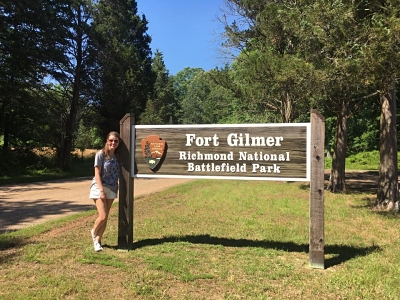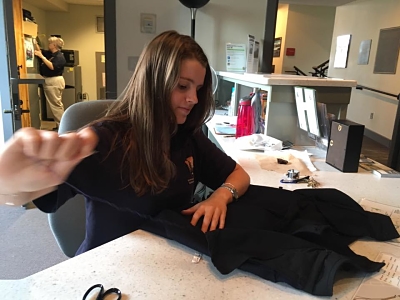Report from the Field: Amelia Gilmer on Her Summer Internship (Part 2)
by Amelia Gilmer | | Tuesday, September 12, 2017 - 00:00

Now that the summer is over, I can safely say that working at Richmond National Battlefield Park was incredibly rewarding and enjoyable. Although I faced some challenges working as woman in the male-dominated field of Civil War history, it was so wonderful to spend the day talking about my passion for Civil War history with most of our visitors. Throughout the course of this internship, I learned so much about the field of public history and historical interpretation. At its core, interpretation is the conscious presentation of resources and facts in such a way that forms a specific argument. There are infinite interpretations of history, and at Richmond National Battlefield Park we strive to create a new, more accurate narrative of the Civil War, one that is not influenced by the Lost Cause.
What I most enjoyed about working for the park was spending a large portion of my time talking with visitors of all ages who were incredibly engaged and wanted to learn more. My youngest visitor was a five-year-old girl named Maddie. Maddie was so enthusiastic about everything and asked so many wonderful questions; we even managed to play “Civil War Princesses” with our Clara Barton costume. Even though she was only five years old, Maddie was already interested in the Civil War and wanted to learn more. As an interpreter, I really wanted to encourage Maddie to learn more about history whether she did so by visiting other historic sites or reading more about the past.
One of our oldest visitors was a man named Richard Paul whose wife was the great-granddaughter of the owner of the Burnett Tavern located at the Old Cold Harbor crossroads. Because the tavern only served cold food, it was referred to as a “cold harbor,” thus explaining the name eventually given to the bloody battle fought nearby from May 31 until June 12, 1864. Mr. Paul brought many artifacts into the visitor center, including a 200-year-old slave made doll and the Bible of a Union solider. Hearing all of his stories, seeing his family’s artifacts, and discussing the war in general was exciting, informative, and illustrated the interpretative value that visitors can share. Informal interpretation is an interactive process, a real exchange of ideas, and so I learned from visitors just as they learned from me.

I learned so much about interpretation through interactions with visitors, specifically the importance of reading people. Sometimes visitors don’t want to talk, they just want to read the maps and look at the cannon and you just have to let them. Other times, visitors just want you to listen, and you have to nod along and listen. I learned that one cannot force interpretation, in that a visitor has to be willing to listen in order for interpretation to occur.
As a woman working in the traditionally male-dominated field of history, one of the challenges I faced was dealing with a few instances of sexism from visitors. I felt that I had to go above and beyond to try to convince these visitors that I was a capable interpreter despite their preconceived notions to the contrary. It was incredibly frustrating to deal with their prejudice toward female interpreters, especially when both my supervisors and I know that I am just as capable as any male intern working in this field.
However, one bright light in this challenge was that my two direct supervisors were both women and provided me with incredible advice. The park’s chief of interpretation and my mentor, Andie Dekoter, was truly an inspiration, possessing interpretive skills just as strong as those of her male coworkers. Andie showed me that it is possible to be a successful female supervisor in a male-dominated field. One of my other supervisors, Stephanie Pooler, taught me the necessary skills to work for the Park Service and how to be an asset to any park. Stephanie always offered incredibly helpful advice when I would come to her with a problem or even a general question. Additionally, Stephanie came from a nature park background, yet she excels as the education coordinator and acting head ranger at a historical park. This really goes to show, that regardless of one’s background, the general principles of interpretation are the same and adaptable to any national park. Thus while I would love to work at a Civil War Park in the future, I could just as easily work at a nature park or another historical site
As much as I loved the interpretive moments, my internship was filled with some other not so glamorous tasks, which were crucial to the successful operation of the park. Whether it was cleaning the glass exhibits, taking out the trash, or mending costumes in the kids corner, I spent a portion of my day making sure the visitor center was in tip-top shape. Even though these tasks might be considered menial, they were important for the visitor center’s operations. Visitors can’t see the exhibits if there are fingerprints all over the glass, and kids won’t want to spend time in the kids’ corner if it’s a mess. I learned that even the smallest tasks are incredibly important in visitor experience and creating a productive environment for interpretation.

All in all, I thoroughly enjoyed my internship and I leaned so much. Without the Nau Center, I would not have had this incredible opportunity, and thus I am so grateful to everyone at the Center. I truly had an unforgettable summer, and I hope to one day return to the park as a ranger.
